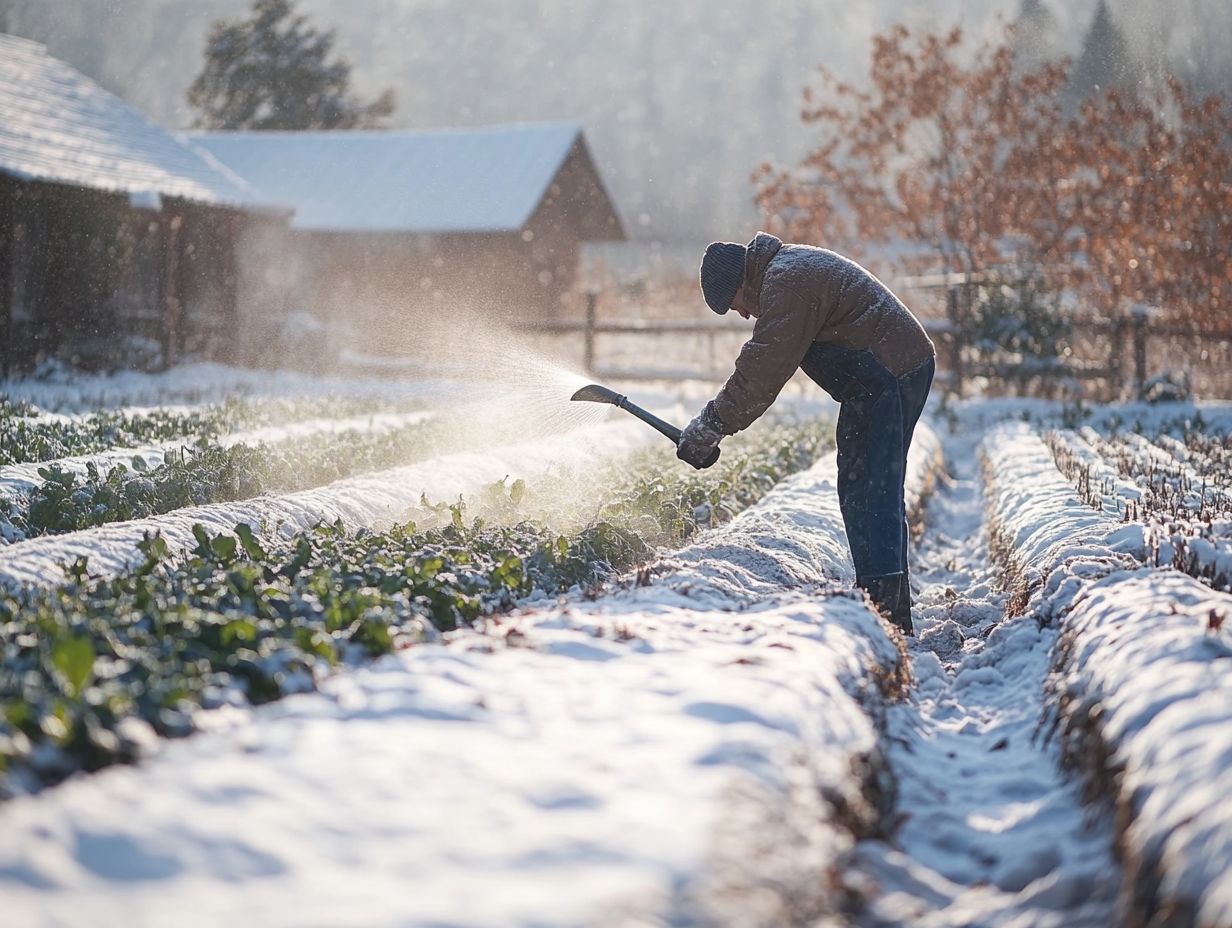Best Practices for Watering Winter Crops
As winter envelops the landscape, you might find yourself pondering how to best care for your crops during these colder months. Proper watering becomes paramount for maintaining plant health, even as temperatures dip.
This article delves into the importance of winter watering, highlighting the key factors you should consider and the best practices to ensure your crops not only survive but thrive despite winter’s challenges.
From grasping the nuances of soil moisture to employing effective watering techniques, here are essential tips to nurture your plants through the frost.
Contents
- Key Takeaways:
- Understanding Winter Crop Watering
- Factors to Consider Before Watering
- Best Practices for Winter Crop Watering
- Additional Tips for Winter Crop Watering
- Frequently Asked Questions
- 1. What are the best practices for watering winter crops?
- 2. How often should I water winter crops?
- 3. Can I use the same watering schedule for winter crops as I do for summer crops?
- 4. Should I water winter crops during freezing temperatures?
- 5. What is the best time of day to water winter crops?
- 6. How should I water winter crops in a drought?
Key Takeaways:

- Watering is crucial for winter crops to survive and thrive.
- Consider soil moisture levels and weather conditions when deciding how often to water.
- Pay attention to the timing and method of watering for the best results.
Understanding Winter Crop Watering
Winter crop watering is vital for keeping your plants healthy. Proper watering techniques ensure that dormant plants get the hydration they need, supporting their roots and preventing issues like root rot. To enhance your success, consider reading about how to choose the best location for winter crops.
In colder climates, you must adjust your landscape maintenance and garden care. Factors such as soil moisture and seasonal temperatures can shape your watering schedule.
Using effective watering methods can help you face the unique challenges of winter gardening, especially for container plants and evergreen trees.
Why Watering is Important During Winter
Watering during winter is essential, as it directly influences your plants’ hydration and their ability to withstand the dormant phase.
When temperatures drop and precipitation dwindles, don’t let winter’s chill fool you consistent watering is key to your plants’ survival! Maintaining adequate soil moisture acts as a protective buffer, allowing your dormant plants like perennials and shrubs to preserve their health and vigor.
Studies show that plants receiving sufficient hydration in winter enjoy a 30% higher survival rate compared to those left parched. This becomes especially crucial in regions where winter can be particularly harsh; proper winter watering enhances your plants’ resilience against freezing temperatures and drying winds.
By ensuring the soil remains adequately moist, you can significantly boost your plants’ chances of thriving come spring.
Factors to Consider Before Watering
Before you establish a watering schedule for your winter crops, it’s essential to consider several important factors, such as soil type, weather conditions, and the specific needs of your plants. Additionally, implementing best practices for winter fertilization can greatly impact the overall health and productivity of your garden.
Different soil types be it sandy, clay, or loamy determine water retention and drainage, which in turn affects how frequently you should water. Varying weather conditions, including temperature fluctuations and precipitation patterns, will require you to fine-tune your watering routine to achieve optimal hydration and health for your plants.
Soil Type and Moisture Levels

The type of soil in your garden is crucial for determining moisture levels and, as a result, the frequency of watering you ll need during winter. Different soil types whether sandy loam or clay have distinct characteristics that dictate how they retain moisture.
Sandy soils drain swiftly, often requiring more frequent watering, while clay soils can retain water, which may lead to issues like root rot if not carefully monitored. To navigate these challenges, it s vital to grasp the specific needs of your plants and implement best practices, such as applying mulch to help retain moisture and regularly checking drainage.
Using moisture meters can also be incredibly effective for keeping tabs on soil conditions throughout the winter months, ensuring your plants stay healthy and well-hydrated without the risk of overwatering.
Weather Conditions and Plant Needs
Weather conditions, such as temperature and humidity, greatly impact the watering needs of your plants during winter.
As the cold months unfold, maintaining the right balance between soil moisture and plant hydration becomes essential for their overall health. For instance, evergreen trees may need less water because their water loss through leaves drops in cooler temperatures, but their roots still require consistent moisture to avoid drying out.
In contrast, container plants often dry out more quickly due to their limited soil volume and exposure to wind. Understanding these variations gives you the power to fine-tune your watering techniques, ensuring that each plant receives the precise amount of water tailored to the unique weather patterns and environmental conditions they face.
Best Practices for Winter Crop Watering
Follow these best practices to boost the health of your winter garden! Implementing effective watering strategies will transform your plants’ hydration while avoiding issues like root rot. For comprehensive tips, check out the ultimate guide to winter crop care.
Establish a well-structured watering schedule and consider using tools such as a water meter and automatic sprinklers to streamline the process and increase efficiency.
Understanding the right watering frequency for different plants, including perennials and vegetable gardening, is crucial for successful cold weather gardening.
Timing and Frequency
Establishing an appropriate watering schedule during winter requires thoughtful consideration of timing and frequency, tailored to the specific environmental conditions around you.
Recognizing that daily temperature fluctuations can significantly influence both evaporation rates and the soil’s ability to absorb moisture is essential. Feel the soil to assess moisture levels, ensuring it s neither too dry nor overly saturated before you begin watering. A moisture meter can be a valuable tool, offering precise readings to guide your decisions.
As daylight hours dwindle and temperatures fall, the needs of certain plants may shift. Scaling back on water may be crucial for more sensitive species to prevent root rot, while hardier varieties might still thrive with regular moisture, but in smaller quantities as the seasons change.
Methods of Watering

Choosing the right watering methods is essential for your winter gardening endeavors. Utilizing essential equipment for winter crop care can effectively meet the unique demands of various plants during the colder months.
Drip lines provide a focused approach, delivering moisture directly to the roots, which minimizes water wastage and encourages deeper soil penetration. Meanwhile, automatic sprinklers can cover larger areas but require careful tuning to avoid over-saturation, which can lead to root rot.
Container plants, in particular, often need more frequent watering, as they tend to dry out more quickly than those planted in the ground. By understanding how each method affects water depth and soil moisture, you can significantly enhance the health and vitality of your winter garden.
Additional Tips for Winter Crop Watering
Enhancing your winter crop watering strategy involves adopting techniques that not only protect your plants from frost but also conserve water and minimize runoff. By following the best practices for winter watering, you can ensure your crops thrive even in the coldest months.
Start applying these tips today to see your plants thrive this winter!
Protecting Plants from Frost and Cold
Protecting your plants from frost and cold is essential for successful winter gardening, ensuring their survival and overall health.
As temperatures drop, using a variety of strategies can significantly bolster your garden’s resilience against the chill. Consider using covers like floating row covers or frost blankets to shield your sensitive plants from harsh winds and frostbite.
Mulching around the bases of your plants serves as excellent insulation, helping to retain soil warmth and moisture. Choose your planting spots wisely! Locations near south-facing walls will give your plants an extra layer of protection.
For evergreen trees and other vulnerable plants, wrapping the trunks with burlap or using tree guards can prevent damage while keeping the foliage safe during winter’s frosty grasp.
Conserving Water and Preventing Runoff
Conserving water while preventing runoff is crucial for smart winter watering methods that ensure your landscape remains in peak condition.
Incorporating simple yet effective strategies, like integrating rain barrels into your landscape, allows you to capture and store valuable rainwater for those drier winter months.
Optimizing your water system for your plants is equally vital; ensuring timers and sensors are set correctly can significantly reduce unnecessary watering. These garden tips conserve water and prevent excess runoff, which can lead to soil erosion.
Enhancing soil absorption through methods like mulching or aeration improves water retention, allowing your plants to thrive while minimizing waste. Using the right pots and soil helps retain water, too. Embracing these practices supports a healthier environment and demonstrates responsible stewardship of natural resources.
Frequently Asked Questions

1. What are the best practices for watering winter crops?
The best practices include adjusting watering schedules according to weather conditions, watering deeply and infrequently, and avoiding watering during the coldest parts of the day. Additionally, utilizing essential tools for protecting winter crops can further enhance your gardening efforts.
2. How often should I water winter crops?
It is recommended to water winter crops every 7-10 days, but this can vary depending on the crop, soil conditions, and weather. To optimize your approach, consider the best practices for winter planting and monitor soil moisture levels to adjust watering accordingly.
3. Can I use the same watering schedule for winter crops as I do for summer crops?
No, adjust your watering schedule for winter crops. They require less frequent watering due to lower evaporation rates and shorter days.
4. Should I water winter crops during freezing temperatures?
Never water your crops during freezing temperatures! This can harm your plants. It is best to water during the warmest part of the day to allow the water to soak in before temperatures drop.
5. What is the best time of day to water winter crops?
The best time to water winter crops is during the warmest part of the day, typically mid-morning to mid-afternoon. This allows the water to soak in and prevents it from freezing on the plants, following best practices for winter gardening.
6. How should I water winter crops in a drought?
In a drought, prioritize watering for essential crops and use methods like drip irrigation or soaker hoses to conserve water. Mulching around the base of plants also helps retain moisture and lessens the need for frequent watering.
Ready to protect your garden this winter? Start using these tips today!






